---------------------------------------------------------------------------------------------------------------------
Author's Statement for Transparency and Disclosure
The test sample/s featured in this article have been provided for technical testing and review by the manufacturer. Test samples are retained by the reviewer following publication of the completed review for the purposes of long term testing and product comparisons.
All output figures and test results published in this review are the sole work of the reviewer, and are carried out independently and without bias. Test results are reported as found, with no embellishments or alteration. Though best endeavours are made to maintain the accuracy of test equipment, the accuracy of these results is not guaranteed and is subject to the test equipment functioning correctly.
----------------------------------------------------------------------------------------------------------------------
Author's Statement for Transparency and Disclosure
The test sample/s featured in this article have been provided for technical testing and review by the manufacturer. Test samples are retained by the reviewer following publication of the completed review for the purposes of long term testing and product comparisons.
All output figures and test results published in this review are the sole work of the reviewer, and are carried out independently and without bias. Test results are reported as found, with no embellishments or alteration. Though best endeavours are made to maintain the accuracy of test equipment, the accuracy of these results is not guaranteed and is subject to the test equipment functioning correctly.
----------------------------------------------------------------------------------------------------------------------
As a 'Performance Review', this thread contains the measured output and runtime figures for the NITECORE EC11, EA11, MH20 and EA41 2015
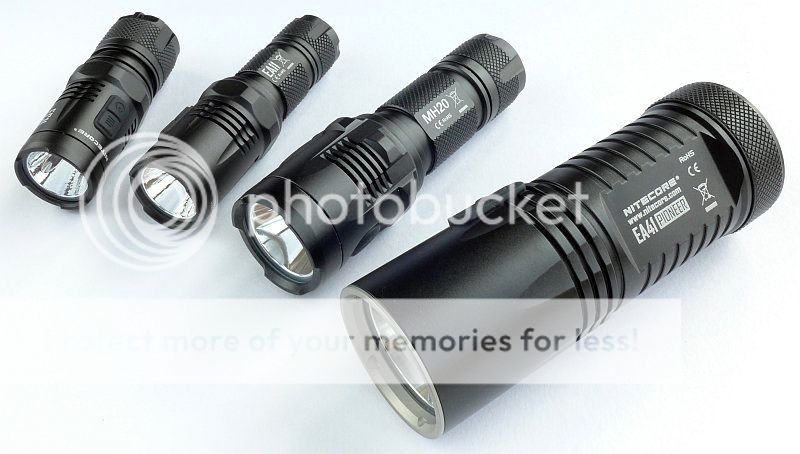
Why a 'Performance Review'?:
In some cases I'm only able to run some of the technical tests on a particular light. A 'Performance Review' in intended to provide an outlet for this information and a placeholder for further updates and discussion.

The group on test here are a set of small powerhouses from NITECORE. The EC11 and EA11 are high performance pocket rockets where IMR cells are recommended, the MH20 is called a 'pocket searchlight' by NITECORE, and the EA41 is a great AA-powered mini searchlight.
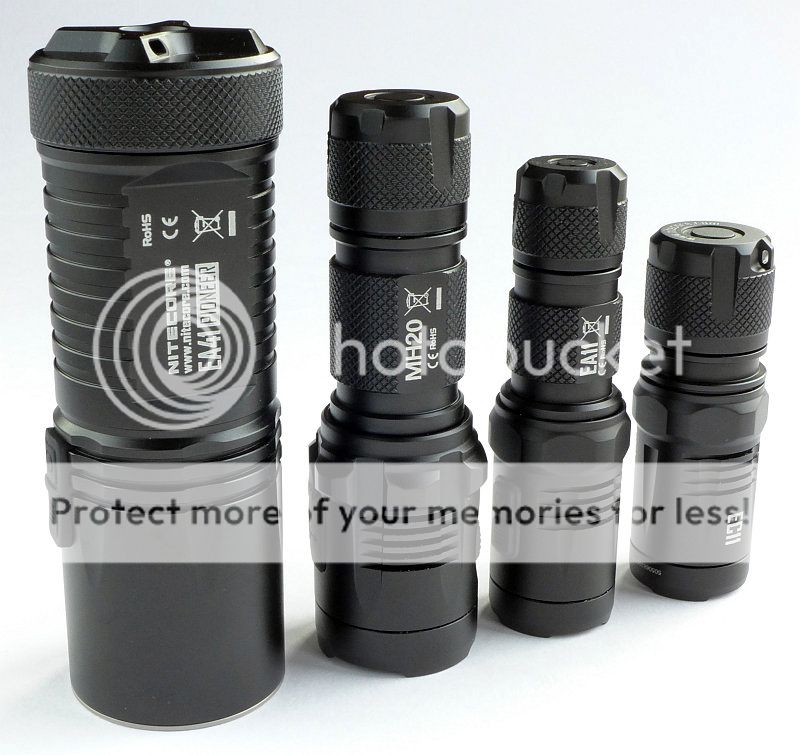
The beam
Please be careful not to judge tint based on images you see on a computer screen. Unless properly calibrated, the screen itself will change the perceived tint.
The indoor beamshot is intended to give an idea of the beam shape/quality rather than tint. All beamshots are taken using daylight white balance. The woodwork (stairs and skirting) are painted Farrow & Ball "Off-White", and the walls are a light sandy colour called 'String' again by Farrow & Ball. I don't actually have a 'white wall' in the house to use for this, and the wife won't have one!
So you can see the different beams, here are the beamshots for each light in an animated gif. Indoor beamshots first.
For both indoor and outdoor the exposure of each frame is the same and each light was on its highest output setting with the photograph taken as close to the '30s from turn on' as possible.
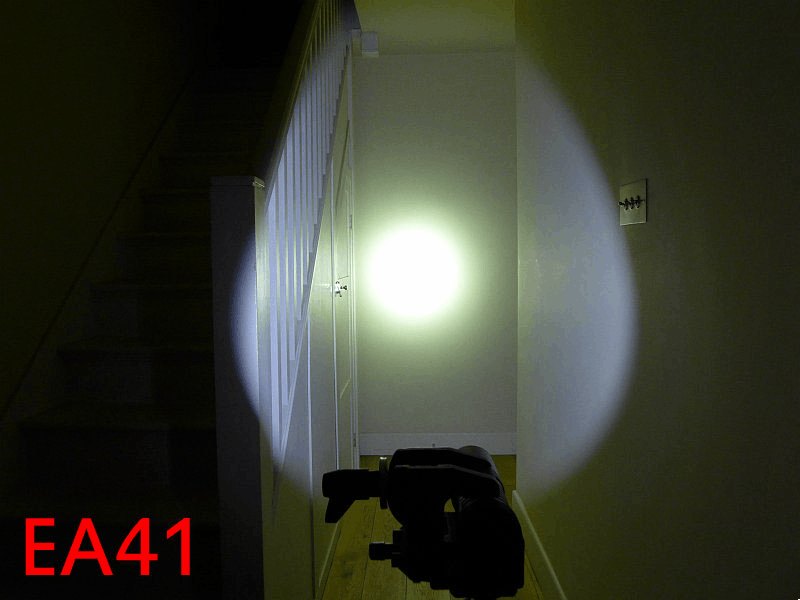
And onto the outdoor beamshots.
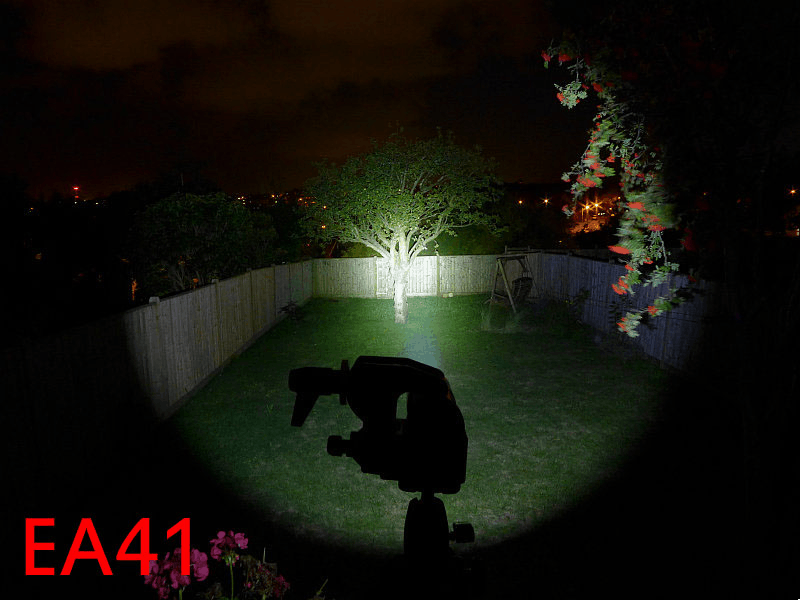
Modes and User Interface:
Please see the manufacturer's website for details of the user interface.
Batteries and output:
The EC11 runs on CR123, RCR123 and 18350.
The EA11 runs on AA or 14500
The MH20 runs on and recharges 18650
The EA41 2015 runs on 4xAA
To measure actual output, I built an integrating sphere. See here for more detail. The sensor registers visible light only (so Infra-Red and Ultra-Violet will not be measured).
Please note, all quoted lumen figures are from a DIY integrating sphere, and according to ANSI standards. Although every effort is made to give as accurate a result as possible, they should be taken as an estimate only. The results can be used to compare outputs in this review and others I have published.
| ___________________________________________ | ________________________________ | ________________________________ |
| EC11 using specified cell | I.S. measured ANSI output Lumens | PWM frequency or Strobe frequency (Hz) |
| ___________________________________________ | ________________________________ | ________________________________ |
| Turbo – RCR123 | 707 | 0 |
| High – RCR123 | 389 | 250 |
| Medium – RCR123 | 211 | 250 |
| Low – RCR123 | 77 | 250 |
| Lower – RCR123 | 2 | 0 |
| Turbo – 18350 IMR | 1036 | 0 |
| High – 18350 IMR | 585 | 250 |
| Medium – 18350 IMR | 305 | 250 |
| Low – 18350 IMR | 99 | 250 |
| Lower – 18350 IMR | 2 | 0 |
* Beacon and Strobe output measurements are only estimates as the brief flashes make it difficult to capture the actual output value.
A note on Strobe – Starting 2016 I will not be measuring any Strobe outputs
Peak Beam intensity measured 10700lx @1m giving a beam range of 207m.
There is parasitic drain at 80uA meaning it will drain a 650mAh cell in 339 days.
| ___________________________________________ | ________________________________ | ________________________________ |
| EA11 using specified cell | I.S. measured ANSI output Lumens | PWM frequency or Strobe frequency (Hz) |
| ___________________________________________ | ________________________________ | ________________________________ |
| Turbo – AA NiMh | 190 | 0 |
| High – AA NiMh | 101 | 0 |
| Medium – AA NiMh | 45 | 0 |
| Low – AA NiMh | 24 | 0 |
| Lower – AA NiMh | 2 | 0 |
| Turbo – AW 14500 IMR | 991 | 0 |
| High – AW 14500 IMR | 551 | 250 |
| Medium – AW 14500 IMR | 294 | 250 |
| Low – AW 14500 IMR | 103 | 250 |
| Lower – AW 14500 IMR | 2 | 0 |
* Beacon and Strobe output measurements are only estimates as the brief flashes make it difficult to capture the actual output value.
A note on Strobe – Starting 2016 I will not be measuring any Strobe outputs
Peak Beam intensity measured 9300lx @1m giving a beam range of 193m.
There is parasitic drain at 267uA using AA meaning it will take 297 days to drain a 1900mAh cell.
There is parasitic drain at 206uA using 14500 meaning it will take 182 days to drain a 900mAh cell.
For the EA11 and EC11 and the cell types used above, here are the runtime traces.
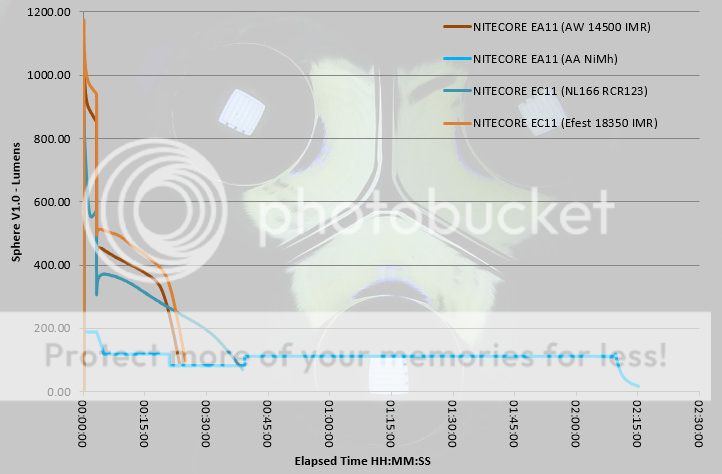
The first part of the graph is a little congested, so here is just the first part.
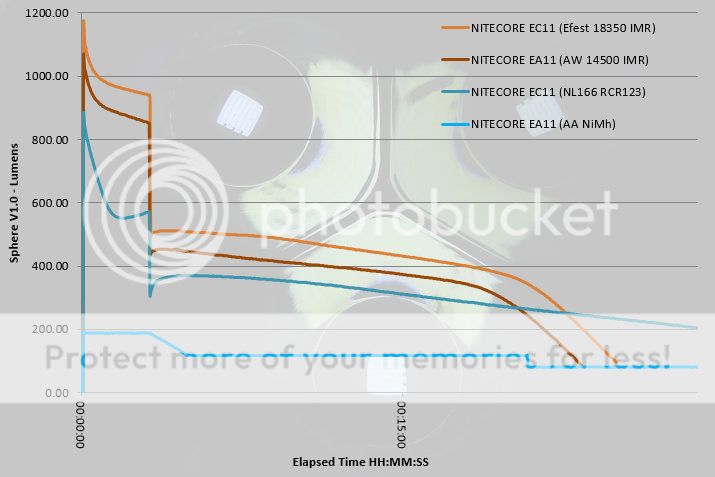
| ___________________________________________ | ________________________________ | ________________________________ |
| MH20 using 18650 | I.S. measured ANSI output Lumens | PWM frequency or Strobe frequency (Hz) |
| ___________________________________________ | ________________________________ | ________________________________ |
| Turbo | 957 | 0 |
| High | 563 | 0 |
| Medium | 324 | 0 |
| Low | 92 | 0 |
| Lower | Below Threshold (<1.7) |
* Beacon and Strobe output measurements are only estimates as the brief flashes make it difficult to capture the actual output value.
A note on Strobe – Starting 2016 I will not be measuring any Strobe outputs
Peak Beam intensity measured 13800lx @1m giving a beam range of 235m.
There is parasitic drain at 33.2uA meaning it will take 10.65 years to drain a 3100 mAh cell.
| ___________________________________________ | ________________________________ | ________________________________ |
| EA41 2015 using AA Eneloop | I.S. measured ANSI output Lumens | PWM frequency or Strobe frequency (Hz) |
| ___________________________________________ | ________________________________ | ________________________________ |
| Turbo | 945 | 0 |
| High | 556 | 0 |
| Medium | 139 | 0 |
| Low | 48 | 0 |
| Lower | 2 | 0 |
* Beacon and Strobe output measurements are only estimates as the brief flashes make it difficult to capture the actual output value.
A note on Strobe – Starting 2016 I will not be measuring any Strobe outputs
Peak Beam intensity measured 31863lx @1m giving a beam range of 357m.
There is parasitic drain, and just like the earlier version of the EA41 I reviewed there is an important feature to understand.
On inserting fresh cells, the EA41 draws 565uA and would drain the cells in 140 days. Like this the EA41 is not flashing the switch or anything else, it just draws 565uA.
If however you turn the EA41 on and off again, the drain drops to 80uA and would now take 990 days to drain the cells. A significant difference.
The MH20 and EA41 2015's runtimes compared.
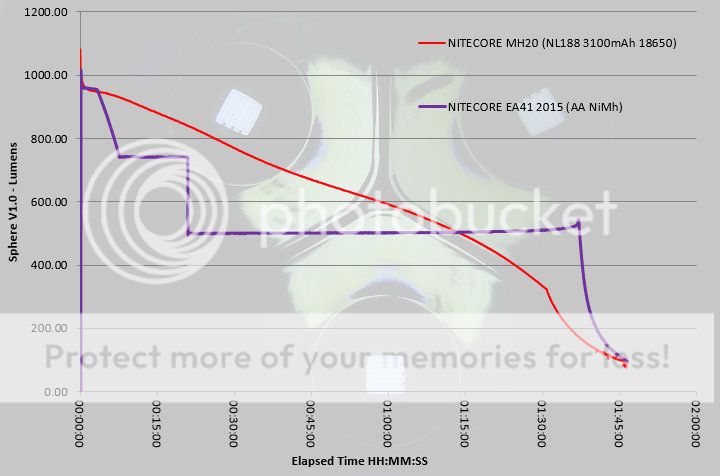
Finally all these traces together to give you an overall comparison.
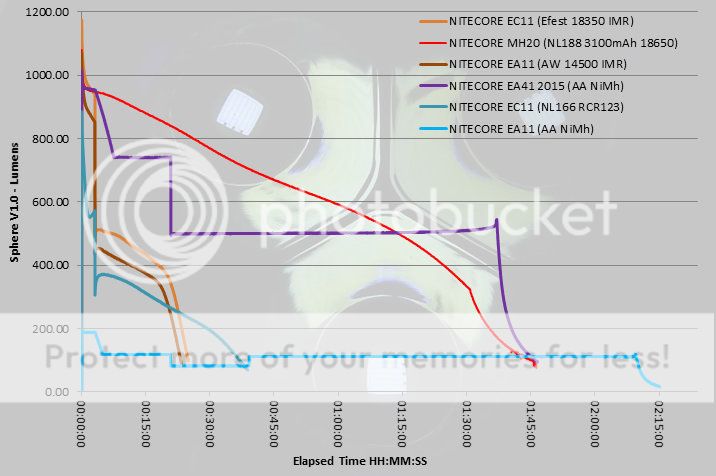
Troubleshooting
This section is included to mention any minor niggles I come across during testing, in case the information helps anyone else.
See the note on the EA41's parasitic drain.
As per the description of this section, this information is provided in case anyone else finds a similar 'issue' that might be fixed in the same way.
A few comments
I'd advise a closer look through the performance figures.
You might note that the EA11 when running on AA does not use PWM, however when on 14500 uses 250Hz PWM on three modes. 250Hz is very apparent to me.
For the EC11 the true performance is only realised with 18350 IMR. On RCR123 the EC11 is struggling, and CR123 is going to be overloaded. Beware of the EC11 and CR123 on Turbo.
The MH20 is a strong performer. However remember that this is also a recharging light with built in micro-USB port. Using this internal charger, 18650s are brought to dead on 4.20V and it draws 0.53A when charging an empty cell. For a full charge of a 3100mAh cell, the MH20 consumed 15528mWh.
The 2015 version of the EA41 has boosted output over the earlier EA41. The parasitic drain is also slightly lower, so a definite upgrade over the earlier version (though you would not 'see' the difference side by side). Remember that 'feature' where the parasitic drain is excessively high on inserting new cells until you switch it on and off the first time.
There is a lot of detail in the reported results, so hopefully you will find this useful.
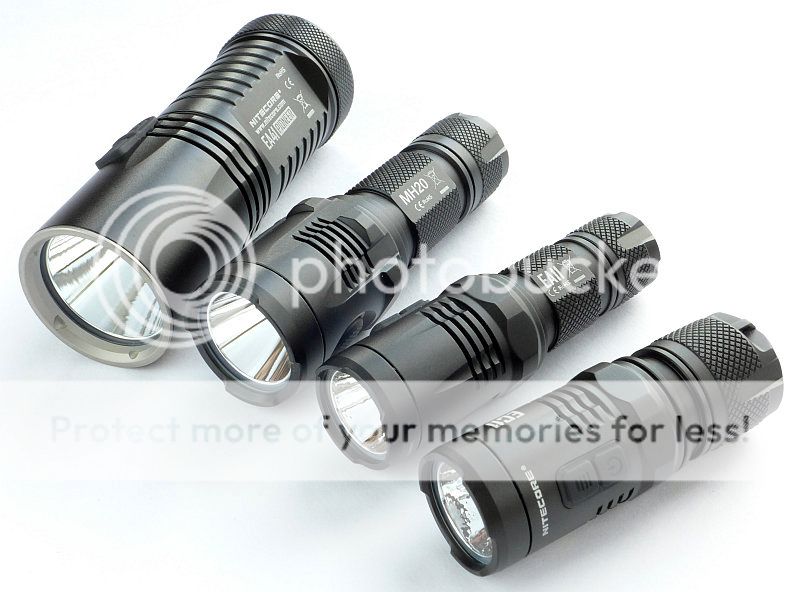
If you enjoyed my reviews, please remember to 'Like' me on Facebook and follow me on Twitter @Subwoofer_CPF
to get all the latest updates and news.
You can also find exclusive insights on Instagram and Pinterest





to get all the latest updates and news.
You can also find exclusive insights on Instagram and Pinterest

Last edited:

